
Choosing the proper lighting for your home can be overwhelming, especially for beginners. But did you know that good lighting can affect your mood and even make your space appear bigger?
While good lighting plays a colossal role in home decor in any design scheme, choosing the appropriate lighting can be overwhelming. We've put together a beginner's guide to lighting in interior design, covering all the basics you need to know to transform your space into a bright and beautiful oasis.
So, if you're ready to banish bad lighting and create a welcoming and cosy atmosphere, keep reading and dive into the world of lighting!
Make a plan

Before buying fixtures and redecorating, consider how you want your space to look and feel. What is the room's function, and what activities will occur inside? Will you dine, relax, or work in this space? Establishing this will help you determine the type and placement of lighting needed to create the perfect ambience.
A well-planned lighting scheme will create a layered effect, using different types of lighting to achieve the desired result. Consider the style, scale, output, and even colour temperature of lights before rushing into design decisions. Early planning creates fewer headaches and confusion down the road.
Determine the type of lighting
There are three types of lighting designers use to create style and functionality - general lighting, task lighting, and accent lighting. Each type can instantly create a different mood, highlight certain features, and make a space feel welcoming and comfortable.
Ambient lighting provides overall illumination, such as overhead lights or recessed lighting. Accent lighting highlights a particular feature, such as artwork or architectural detail. The last one, task lighting, is focused on a specific area, such as a desk or kitchen counter.
After you determine which lighting you’d like to achieve, you can now consider the purpose of your room and how you can use each type to create a balanced effect.
Choose the right fixtures

Once you have a plan for your lighting, it's time to choose the fixtures. There are countless options, from chandeliers to floor lamps to recessed lighting. Choose fixtures that complement your decor style and the purpose of the room.
For example, a modern pendant light might be perfect for a dining room, while a vintage table lamp might be ideal for a cosy reading nook.
Consider the colour temperature

Lighting comes in different colour temperatures, such as warm white, cool white, or even “Lumens.” Warmer temperatures create a cosy, relaxing atmosphere, while cooler temperatures provide a brighter, more energising light.
Colour temperature is often expressed in kelvins. The lower this number, the closer it is to the yellow colour. While a higher colour temperature means the emitted light is closer to the whiter shade. Consider the colour of your walls, furniture, and decor when choosing the colour temperature for your lighting.
Use dimmer switches
Dimmer switches are a great way to add flexibility to your lighting scheme because they allow you to adjust your lights' brightness while creating a more relaxed, intimate atmosphere when needed.
Dimmers are particularly useful in living areas and bedrooms to set the mood depending on the time of day or activity. Besides their versatility, dimmer switches are energy-efficient.
Less is more, with natural light

Natural light is an essential part of any interior design scheme. It can create a sense of openness and brightness and is suitable for your health and well-being. Consider the placement of windows and how the natural light will interact with your artificial lighting scheme. Be sure to choose window treatments that control the amount of light entering your space.
A quick guide to lighting in each room
Consider what tasks you may be undertaking in each room where lighting can affect or aid you. Here is a guide and some lighting tips for different areas of the home:
Living room
Overhead lighting and spotlights that highlight your artwork or other decor items work best in the living room. When you have guests, you can use ambient lighting, whereas task lighting is sufficient if you want to switch it to a reading corner.
Kitchen
Cooking and kitchen activities require more concentrated lighting. Therefore, bright general lighting in prep areas like countertops and the above stove is helpful.
Bathroom and powder rooms
Mount fixtures above or on either side of the mirrors for bathrooms to minimise shadows. Powder rooms need a combination of sidelights and downlights, and use the dimmer to get the most out of the lights.
Bedroom
The bedroom should have a combination of ambient, accent, and task lighting, to match your mood. To get the most out of the lighting arrangement, you can use accent lighting as nightlights or to illuminate specific spots.
To conclude...

With a bit of planning and consideration, you can create a lighting scheme that enhances the look and feel of your space.
Remember to consider the purpose of each area, choose suitable types of lighting, fixtures, and colour temperatures, and use dimmers to add flexibility. And don't forget about natural light – it's free, beautiful, and good for you. So go forth and light up your world!
Click here for more on apartment living, lifestyle, news, and market insights.
Header image of Nineteen First Avenue. Click here to learn more.


